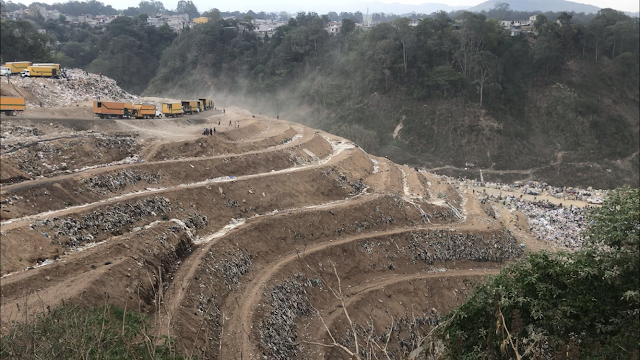We started our day nice and early arriving at the airport at 4:30 AM. After two flights and nine hours of travel we finally landed in Guatemala City where Andrea, our CASA leader, was waiting for us. What was even better than Andrea waiting for us, was the food back at Semilla waiting for us! We enjoyed homemade corn tortillas (Guatemala's staple food) for the first time. After our belly's were full it was time to exchange our U.S. dollars for Guatemala's currency, the Quetzal. We headed to the high class mall where we quickly learned that a dollar was worth a lot more than a Quetzal. One Quetzal equals 0.13 cents. Then we returned to the nearby neighborhood to experience a Guatemalan plaza. There was a bakery where a donut was 2.25Q, which is approximately 0.29 cents in the U.S. We were all amazed at how inexpensive everything was at the grocery store as well. After our first long day in Guatemala we were all ready to head back to Semilla for a good dinner and movie about the history of Guatemala before we went to bed.
We started our day with some tostada francesa- french toast- from Rena the cook at Semilla. Our first speaker, Hector Castenada, covered a brief history of colonialism and racism as causes of poverty in Guatemala. Hector was Spanish and an indigenous Guatemalan which is also known as Ladino. He was born in Guatemala, but he lived in the U.S. for a period of time where he attended Case Western. After his study, he returned to Guatemala to help his home country. He explained the history of Guatemala starting with 1492, when the Spanish arrived and took control of the country, making the Guatemalan people basically their slaves. Then in 1879, the Spanish left Guatemala which gave the indigenous people hope but it was shattered when the Ladinos took their spot in the government and took over the Spanish attitude toward the indigenous people keeping them in poverty. The Ladinos only made up 35% of the population, but the elite 10% own 88% of the best land and have most of the power. Between 1944-1954, everything in Guatemala started to change. They had free elections for the first time getting rid of corrupt and unjust politicians and leaders. During this period more schools were built and reform laws were made, and there was finally hope in Guatemala, until 1954. In 1950, the president began talking about land reform to help address poverty. The U.S. felt threatened by his ideas, especially the United Fruit Company who owned thousands of acres of fruit plantations. Therefore, the U.S. used its influence to help the elite overthrow the government and replace it with military leaders. Eventually, the people who were in poverty became fed up with the unjust treatment and started a revolt which lead into a civil war that lasted 36 years. It ended by a peace accord which gave indigenous people some rights, but it did not even come close to fixing the problems of poverty. As of today, only 12% of the best land is owned by common Guatemalan people. The rest is owned by multinational corporations, the Guatemalan elites leaving 60% of the country in poverty.
We visited the Guatemalan cemetery that was filled with different tombs illustrating the difference between the elite/upper class, middle class, and lower class. The picture below is of the lower class graves. The lower class has to pay a yearly fee to keep their loved ones stored there. If they aren't able to pay that fee the bones are returned to the family.
The upper class tomb is pictured below is a military general's. It's enormous compared to the other tombs present in the cemetery. It illustrates the large monetary gap between the lower class and the elite, but that doesn't even include the lowest level of social class that cannot even afford a tomb.
After visiting the cemetery, we walked 20 feet to the dump which is seen in the video below. The people that are seen in the video are searching for recyclable goods that they can sell for 26 American cents a pound.
To top off our days excursions, we headed to the central plaza where we saw the Cathedral, the Presidential Palace, and we walked down the central Avenue to compare the prices here to U.S. clothing prices. The Guatemalan goods were very cheap due to the low wages (minimum wage $1.00 hour). Finally, we visited a fruit market where we purchased a native fruit to try after it was prepared by the Semilla cook.






No comments:
Post a Comment